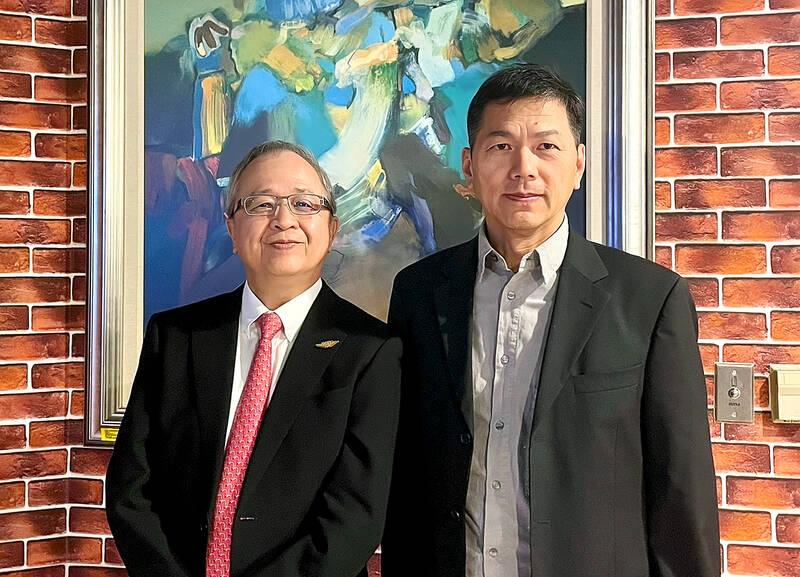Industrial computer maker Flytech Technology Co (飛捷科技) yesterday said it would continue to enhance its gross margin amid the impacts of the New Taiwan dollar’s appreciation and US tariffs.
The company would continue to boost operational resilience through artificial intelligence (AI) integration, in-house module development and high value-added products, Flytech chairman Lam Tai-seng (林大成) told reporters after its annual shareholders’ meeting in Taipei.
Flytech’s products mainly comprise smart point-of-sale systems, touch-panel PCs, mobile terminals, self-service kiosks, embedded computers and unified endpoint management software, the company’s Web site showed.

Photo: Fang Wei-chieh, Taipei Times
As Flytech exports products under free-on-board terms, the higher US tariffs would be borne by clients, who have not asked the company to absorb the costs, Lam said.
However, the higher tariffs could still affect some product prices and plans, he said.
Regarding the sharp appreciation of the NT dollar against the US currency, Lam said it is estimated to cut the company’s gross margin by 4.5 to 5 percentage points, given that about 40 percent of its products are priced in US dollars.
The exchange rate fluctuations are expected to affect the company’s sales performance, but it has made significant efforts in product design to help maintain its gross margin, he said.
First-quarter gross margin stood at 44.62 percent, up from 42.99 percent a year earlier, while revenue grew 34.31 percent year-on-year to NT$1.36 billion (US$45.4 million), company data showed.
The main driver of revenue growth was its customized services, Lam said, adding that the business outlook in the second half of the year would be better than the first half due to stable demand.
Asked about the company’s plans to build new plants, Lam said it would depend on how tariff policies develop.
Flytech has no plans to set up a facility in the US due to high costs and an incomplete supply chain, he said.
However, the company is assessing the possibility of setting up factories in Vietnam or Thailand as it aims to diversify risks and meet demand from regional clients, he added.
North and South America accounted for 52 percent of Flytech’s revenue last year, followed by 38 percent from Europe, the Middle East and Africa, and 10 percent from the Asia-Pacific region.
Shareholders yesterday approved the company’s proposal to distribute a cash dividend of NT$6 per share, the highest since 2017.
Revenue last year grew 32.04 percent year-on-year to NT$4.61 billion, and net profit reached NT$958.76 million, up 102.82 percent year-on-year. Earnings per share were NT$6.93.

Taiwan Semiconductor Manufacturing Co (TSMC, 台積電) last week recorded an increase in the number of shareholders to the highest in almost eight months, despite its share price falling 3.38 percent from the previous week, Taiwan Stock Exchange data released on Saturday showed. As of Friday, TSMC had 1.88 million shareholders, the most since the week of April 25 and an increase of 31,870 from the previous week, the data showed. The number of shareholders jumped despite a drop of NT$50 (US$1.59), or 3.38 percent, in TSMC’s share price from a week earlier to NT$1,430, as investors took profits from their earlier gains

In a high-security Shenzhen laboratory, Chinese scientists have built what Washington has spent years trying to prevent: a prototype of a machine capable of producing the cutting-edge semiconductor chips that power artificial intelligence (AI), smartphones and weapons central to Western military dominance, Reuters has learned. Completed early this year and undergoing testing, the prototype fills nearly an entire factory floor. It was built by a team of former engineers from Dutch semiconductor giant ASML who reverse-engineered the company’s extreme ultraviolet lithography (EUV) machines, according to two people with knowledge of the project. EUV machines sit at the heart of a technological Cold

Taiwan’s long-term economic competitiveness will hinge not only on national champions like Taiwan Semiconductor Manufacturing Co. (TSMC, 台積電) but also on the widespread adoption of artificial intelligence (AI) and other emerging technologies, a US-based scholar has said. At a lecture in Taipei on Tuesday, Jeffrey Ding, assistant professor of political science at the George Washington University and author of "Technology and the Rise of Great Powers," argued that historical experience shows that general-purpose technologies (GPTs) — such as electricity, computers and now AI — shape long-term economic advantages through their diffusion across the broader economy. "What really matters is not who pioneers

TAIWAN VALUE CHAIN: Foxtron is to fully own Luxgen following the transaction and it plans to launch a new electric model, the Foxtron Bria, in Taiwan next year Yulon Motor Co (裕隆汽車) yesterday said that its board of directors approved the disposal of its electric vehicle (EV) unit, Luxgen Motor Co (納智捷汽車), to Foxtron Vehicle Technologies Co (鴻華先進) for NT$787.6 million (US$24.98 million). Foxtron, a half-half joint venture between Yulon affiliate Hua-Chuang Automobile Information Technical Center Co (華創車電) and Hon Hai Precision Industry Co (鴻海精密), expects to wrap up the deal in the first quarter of next year. Foxtron would fully own Luxgen following the transaction, including five car distributing companies, outlets and all employees. The deal is subject to the approval of the Fair Trade Commission, Foxtron said. “Foxtron will be